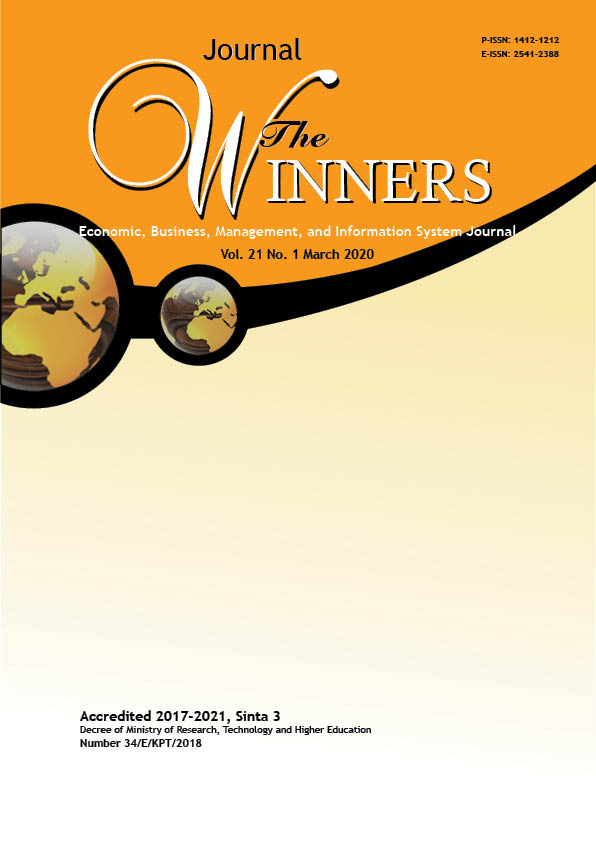Trade Integration Indonesia-ASEAN4 in AEC Era: A Case of Wood-based Products
DOI:
https://doi.org/10.21512/tw.v21i1.5888Keywords:
intra-industry trade (IIT), wood-based product, product differentiation, trade integrationAbstract
The research was conducted to find out the level integration intensity using Grubel-Lloyd index. Moreover, since Horizontal and Vertical Intra-Industry Trade (IIT) could be distinguished, it was important to find out whether Indonesia-ASEAN4 IIT of wood-based products was in one of these categories. The Hufbauer index had been used as the measurement of product differentiation. Therefore, it could be the basic information for taking policy to boost Indonesia-ASEAN IIT for this industry. The data used comprise annual statistics of wood-based product export and import between Indonesia and ASEAN4 from 2010 to 2016 which were divided into eight categories of five digits ISIC. The Grubel-Lloyd index result shows that only ISIC 16102 has achieved strong integration, the others are still in mild and even weak integration. The Hufbauer index results show that all the values approached to zero, indicated that overall wood-based products traded by Indonesia-ASEAN4 are horizontally differentiated.
References
Afreximbank 2018 Audit. (2019). Africa research bulletin: Economic, financial and technical series. https://doi.org/10.1111/j.1467-346.2019.08856.x.
African Economic Outlook. (2017). African economic outlook 2017: Entrepreneurship and industrialisation. In African Economic Outlook. https://doi.org/10.1787/aeo-2017-en.
ASEAN. (2015). ASEAN Economic Community (AEC). 1–4.
Aturupane, C., Djankov, S., & Hoekman, B. (1999). Horizontal and vertical intra-industry trade between Eastern Europe and the European Union. Weltwirtschaftliches Archiv, 135, 62 - 81. https://doi.org/10.1007/BF02708159.
Byun, J. J., & Lee, S.-H. (2005). Horizontal and vertical intra-industry trade: New evidence from Korea, 1991-1999. Global Economy Journal, De Gruyter, 5(1), 1 - 31. https://doi.org/10.2202/1524861.1036.
Chin, M.-Y., Yong, C.-C., & Yew, S.-Y. (2015). The determinants of vertical intra-industry trade in SITC 8: The case of ASEAN-5 and China. Journal of Developing Areas, 49(4), 257 - 270. https://doi.org/10.1353/jda.2015.0128.
Funke, M. & Ruhwedel, R. (2001). Product variety and economic growth - Empirical evidence for the OECD Countries, IMF Staff Papers, 48(2), 225 - 242.
Jambor, A. (2014). Country-specific determinants of horizontal and vertical intra-industry agri-food trade: The case of the EU new member states. Journal of Agricultural Economics, 65(3), 663 - 682. https://doi.org/10.1111/1477-9552.12059.
Jha, A. K., & Saha, S. (2011). Intra-Industry Trade in ASEAN-5: An overall and country-specific study. Journal of International Economics, 2(2), 17 - 24.
Kenya Institute for Public Policy Research and Analysis. (2017). Kenya economic report 2017. In Sustaining Kenya’s Economic Development by deepening and Expanding Economic Integration in the Region. https://doi.org/10.1007/s10842-006-7185-8.
Krugman, P., Obstfeld, M., & Melitz, M. (2015). In International economics, theory and policy (9th Ed.,pp. 159-171). Boston: Pearson.
Martin-Mayoral, F., Carofilis, G. M, & Guijarro, J. C. (2016). The effects of integration agreements in Western Hemisphere trade, 1970–2014. Journal of International Trade and Economic Development, 25(5), 724 - 756. https://doi.org/10.1080/09638199.2015.1125519.
Mendoza Cota, J. E. (2016). Revealed comparative advantages and intra-industry trade changes between Mexico, China and the USA. Portes, 10(20), 8 - 41.
Neraca. (February 5th, 2018). Ekspor produk kayu nasional terus meningkat, target pendapatan USD12miliar di 2018. https://economy.okezone.com/read/2018/02/05/320/1854836/ekspor-produk-kayunasional-terus-meningkat-target-pendapatan-usd12-miliar-di-2018, revered 7 September 2019.
Okabe, M., & Urata, S. (2014). The impact of AFTA on intra-AFTA trade. Journal of Asian Economics. https://doi.org/10.1016/j.asieco.2014.09.004.
Ridhwan, M. M., Wicaksono, G., Nurliana, L., Bary, P., Suryani, F. T. and Satyanugroho, R. (2015). Analisis daya saing dan strategi industri Nasional di era masyarakat ekonomi ASEAN dan perdagangan bebas, Bank Indonesia, WP/3/2015. Retrieved from
http://www.bi.go.id/id/publikasi/wp/Documents/,revered 21 April 2018).
Takamatsu, M (2016). Analysis of factors influencing intra-industry trade in the food sector in the ASEAN region, Food and agriculture organization of the United Nations, Graduate School of Agriculture Kyoto University (Japan). Retrieved from http://agris.fao.org/agris-search/search.do?recordID=JP2019008579.
Yoshida, Y. (2013). Intra-industry trade, fragmentation and export margins: An empirical examination of subregional international trade. North American Journal of Economics and Finance, 24(C), 125 - 138. https://doi.org/10.1016/j.najef.2012.07.003.
Yusefzadeh, H., Rezapour, A., Lotfi, F., Ebadifard Azar, F., Nabilo, B., Abolghasem Gorji, H., … Karami, A. (2015). A study of comparative advantage and Intra-Industry Trade in the pharmaceutical industry of Iran. Global Journal of Health Science, 7(6), 295-307. https://doi.org/10.5539/gjhs.v7n6p295.
Downloads
Published
How to Cite
Issue
Section
License
Authors who publish with this journal agree to the following terms:
a. Authors retain copyright and grant the journal right of first publication with the work simultaneously licensed under a Creative Commons Attribution License - Share Alike that allows others to share the work with an acknowledgment of the work's authorship and initial publication in this journal.
b. Authors are able to enter into separate, additional contractual arrangements for the non-exclusive distribution of the journal's published version of the work (e.g., post it to an institutional repository or publish it in a book), with an acknowledgment of its initial publication in this journal.
c. Authors are permitted and encouraged to post their work online (e.g., in institutional repositories or on their website) prior to and during the submission process, as it can lead to productive exchanges, as well as earlier and greater citation of published work.
USER RIGHTS
All articles published Open Access will be immediately and permanently free for everyone to read and download. We are continuously working with our author communities to select the best choice of license options, currently being defined for this journal as follows: Creative Commons Attribution-Share Alike (CC BY-SA)

















